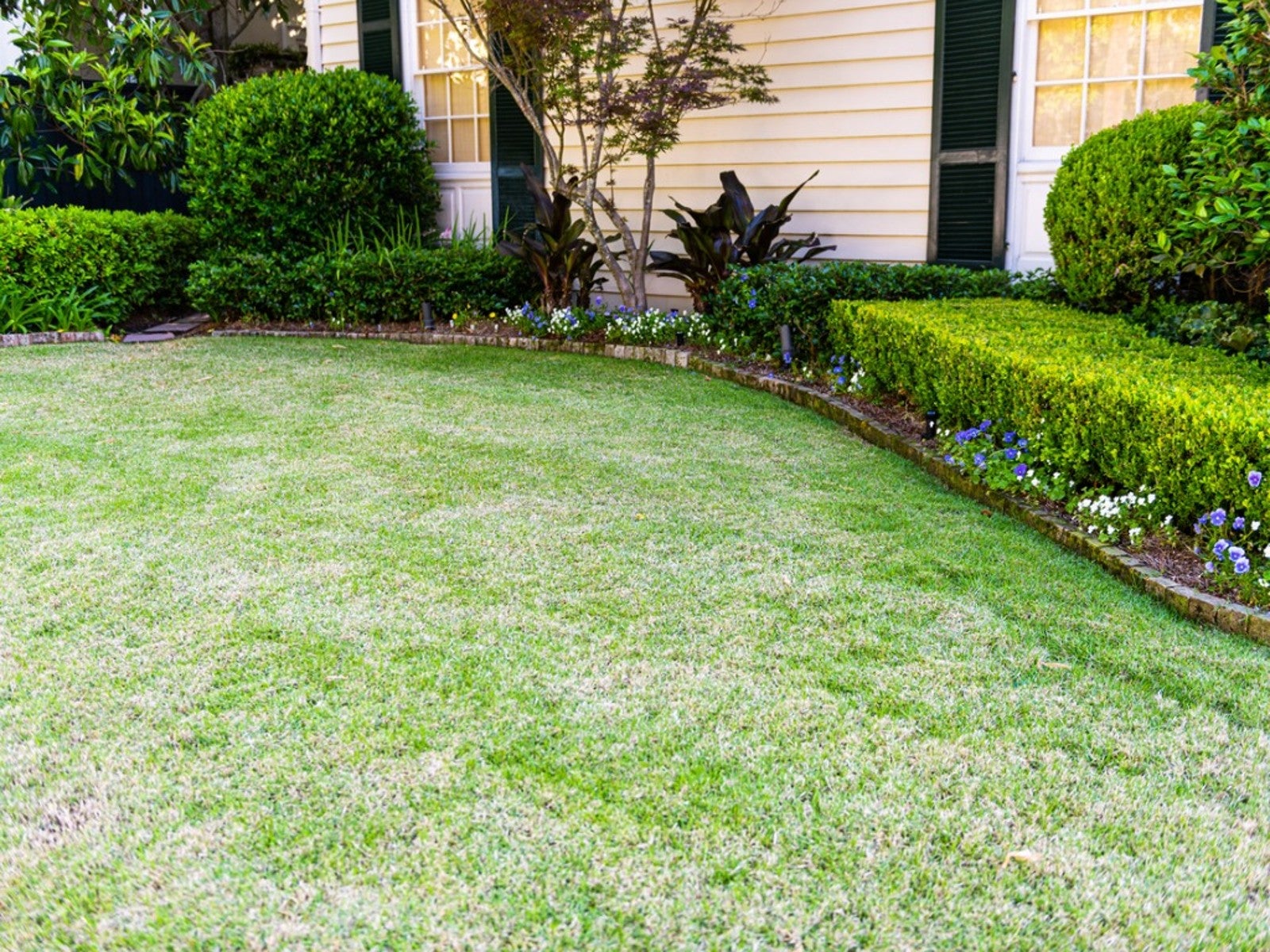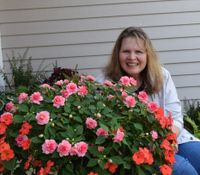Southern Lawn Care Guide And Calendar


Taking care of your southern lawn may seem overwhelming at times, but it doesn’t have to be. Choosing the right lawn grass, plus proper watering, fertilizing, and mowing, will go a long way toward ending that frustration.
Not only is a well-cared for lawn attractive and increases the value of your home, but turfgrass can prevent soil erosion, direct runoff into the groundwater stream, provide a cooling effect through transpiration, absorb noise, produce oxygen, and trap carbon dioxide. What more could you ask of a lawn?
Learning the basics of southern lawn care will ease the maintenance tasks.
Southern Lawn Maintenance Guide and Schedule
Establishing and maintaining a lawn consists of choosing turfgrass suitable for your area, soil, and light, then mowing at the correct height, applying fertilizer, and watering deeply when needed. Controlling weeds as they arrive is also part of a lawn management program.
Here are tips to get the most out of your lawn with the least effort.
Grass Seed for Southern Lawns
Lawn grasses are divided into warm season and cool season grasses. Warm season grasses perform best at temperatures over 80 degrees F. (27 C.), and cool season grasses fare best at temperatures between 60 and 75 degrees F. (16-24 C.). For Southern gardens, recommended warm season grasses include Bermudagrass, Zoysiagrass, St. Augustinegrass, and Centipedegrass. For cool season grasses, consider tall fescue, thin-leaved fescue, or in some areas, Kentucky bluegrass. Check with your county extension agent to see which one is best for your soil type.
Choosing a seed depends greatly on the amount of light available to the lawn. No grass seed performs well in full shade, but some grass seed can tolerate partial shade. Bermudagrass has the least shade tolerance, centipedegrass has medium shade tolerance, and St. Augustinegrass and Zoysiagrass have medium to excellent shade tolerance.
Sign up for the Gardening Know How newsletter today and receive a free copy of our e-book "How to Grow Delicious Tomatoes".
If you are battling full shade under a tree or next to a building, consider a groundcover or mulch instead of grass. Groundcovers for shade include liriope, Asian jasmine, mondo grass, holly fern, and mulch such as bark, pecan shell, and pine straw.
Best Fertilizer for Southern Lawns
Fertilizer is important for your lawn to improve its density, color, and recuperative ability. A healthy lawn can reduce weed invasion and is better able to withstand heat, cold, drought, and foot traffic.
Turfgrass requires nitrogen (N), phosphorus (P), potassium (K), and ten other mineral elements to thrive. Nitrogen is the most important fertilizer for turfgrass since it is used the most and the other nutrients are typically available in many native topsoils. However, deciding how much and what type of fertilizer to use should be based on a soil test. Your county extension offers soil testing as well as other independent labs.
If the P, K, and pH levels are satisfactory, a typical fertilizer program for bermudagrass consists of a May application with a water-soluble complete fertilizer (20-5-10) using 1 pound of N per 1,000 square feet (93 m2), a June application with a slow-release fertilizer of 2 to 3 pounds N per 1,000 square feet (93 m2), and an August application with a slow-release fertilizer of 2 to 3 pounds N per 1,000 square feet (93 m2). If you do not use slow-release fertilizer, more applications would be needed with less fertilizer (June, July, August using 1 pound of N per 1,000 square feet (93 m2), and September using the same as May).
Cool season grasses do not need as much fertilizer as bermudagrass. A program example is to apply a complete fertilizer (20-5-10) in early October of 1 to 1.5 pounds N per 1,000 square feet (93 m2). In early December, apply nitrogen-only fertilizer of 1 to 1.5 pounds N per 1,000 square feet (93 m2). In early March, apply nitrogen-only fertilizer, 0.5 to 1.0 pound N per 1,000 square feet (93 m2). In mid-May, apply a complete fertilizer (20-5-10) with 0.5 to 1.0 pound N per 1,000 square feet (93 m2).
Mowing and Irrigating
Depending on the type of turfgrass, mowing heights will vary. The recommended heights promote a healthy turf that is better able to withstand foot traffic, environmental stresses, and encourage deep roots. Turfgrasses growing in shade should be cut one half inch (1 cm.) higher than normal. Warm season grasses are cut slightly higher in the fall to insulate the leaf blades against cooling temperatures.
- Bermudagrass is recommended to cut one half to three fourths inches (1-2 cm.) in the summer and one to one and one fourth inches (2.5-3 cm.) in the fall.
- Centipedegrass is recommended to cut 1.5 to 2 inches (4-5 cm).
- St. Augustinegrass is recommended to cut 2.5 inches (6 cm.) in the summer and 3 inches (8 cm.) in the fall.
- Zoysiagrass is recommended to cut one half to three fourths inches (1-2 cm.) in the summer and one to one and one fourth inches (2.5-3 cm.) in the fall.
- Tall fescue is recommended to cut 3 inches (8 cm.) in the summer and 2.5 inches (6 cm.) in the fall.
- Kentucky bluegrass is recommended to cut 2.5 inches (6 cm.) in the summer and fall.
Too often lawns are watered frequently and lightly, resulting in a shallow root system that can’t withstand the heat and cold. It is best to water at the first sign of water need, such as “footprinting” and a blue-gray appearance. Water deeply, i.e., to a 6 inch (15 cm.) depth. You can tell if the water has soaked that far by probing the soil. After a few times you will instinctively know how much time and water is needed to achieve deep watering. Early morning is usually the best time to water so that the grass has time to dry, thereby avoiding fungal issues.
Southern Lawn Weeds
Identifying and reducing lawn weeds is an important part of lawn management. With proper watering, fertilizing, and mowing, healthy lawns can ward off most weed invasions. A certain percentage of weeds is tolerable but plan a program utilizing herbicides for best control when weed problems arise.
Annual weeds complete their life cycle in one year but come back the next year from seed. An example of summer annual grassy weeds are crabgrass, goosegrass, and foxtail. Knotweed and spurge are examples of summer annual broadleaf weeds. A pre-emergent herbicide will control them before germination in early spring, or a post emergence herbicide will control them after they germinate and are actively growing.
Winter annual grassy weeds such as annual bluegrass, fescue grass, cheat, and downy brome also can be controlled with pre-emergent herbicides applied prior to germination (August to September) as can winter annual broadleaf weeds such as chickweed and henbit. Postemergence control can be applied when weeds have germinated and are actively growing, usually in October and November.
Perennial weeds such as dallisgrass, dandelion, clover, and nutsedge are harder to control because they can come back from underground plant parts. If you pull out a dandelion and the whole root doesn’t come with it, you can expect to see it grow back. Nutsedge needs a pre-emergence herbicide applied in early spring before germination of nutlets. Then in June, apply a postemergence herbicide (organic arsenicals). Dandelions and clover are best controlled in October and November with a postemergence herbicide such as 2,4-D or 2,4-D plus dicamba.
Southern Lawn Care Schedule
Bermudagrass
- January – Postemergence winter weed control.
- February – Postemergence winter weed control. Keep lawn mowed closely at recommended heights. Most winter weeds cannot tolerate close mowing.
- March – Soil test; correct phosphorus or potassium deficiencies or extreme pH levels; postemergence winter weed control; pre-emergence summer annual grassy weed control at the end of month.
- April – Pre-emergence summer annual grassy weed control the first part of month.
- May – N, P, K fertilizer application; postemergence summer weed control; insect and disease control as problems arise; mowing. May is an ideal time to sprig, plug, or sod bermudagrass. Do not apply pre-emergence herbicides in March or April on areas to be seeded.
- June – N application; postemergence summer weed control; insect and disease control as problems arise; mowing; watering.
- July – Same as June.
- August – N application; sod webworm control as problems arise; watering; mowing.
- September – N, P, K, fertilizer application; pre-emergent winter weed control by the middle of month; watering; begin raising the height of cut.
- October – Begin postemergence winter weed control at the end of month.
- November and December – Soil test; postemergence winter weed control.
-Adapted from Oklahoma and Mississippi Extension

After graduating from Oklahoma State University with a degree in English, Susan pursued a career in communications. In addition, she wrote garden articles for magazines and authored a newspaper gardening column for many years. She contributed South-Central regional gardening columns for four years to Lowes.com. While living in Oklahoma, she served as a master gardener for 17 years.